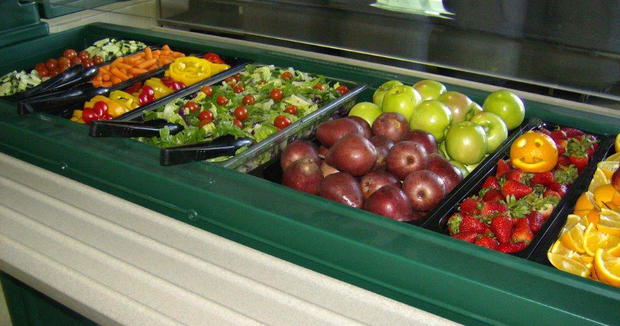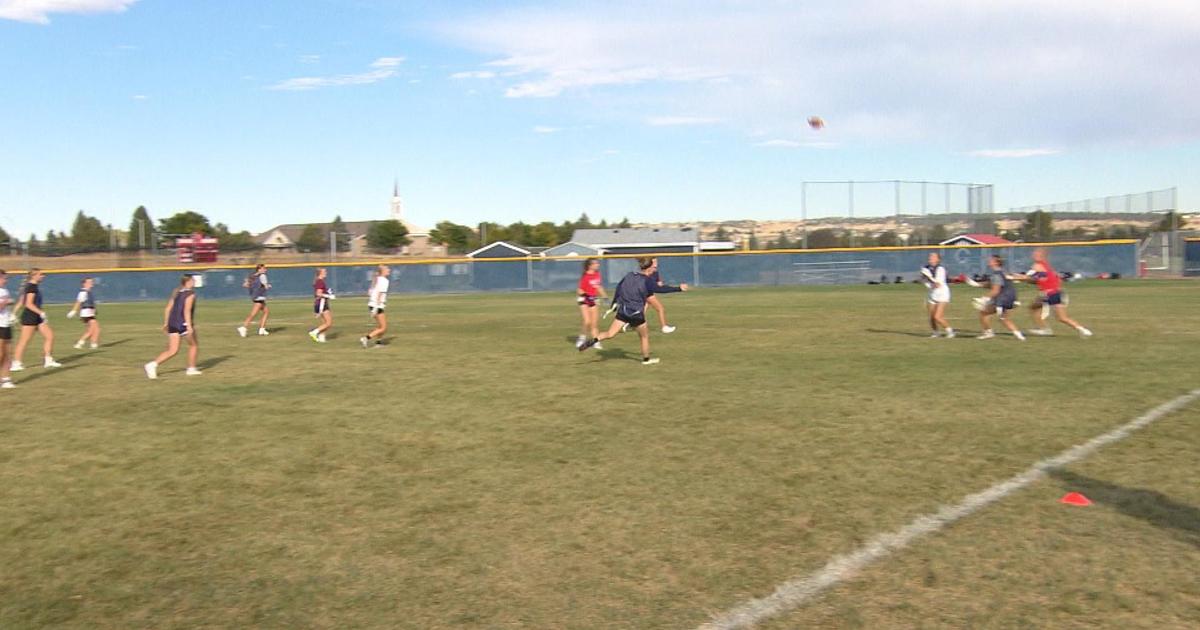Not Your Parents' School Lunch: Districts Innovate With Food Trucks, Smartphone Apps
DENVER (CBS4) - If you attended public schools, you likely remember the lunches you stared down as a student: Options were often unappetizing, institutional in appearance and probably unhealthy.
Sometimes, on lucky days, there was pizza.
But if you don't have kids in public schools today, the meals served now are likely unrecognizable, at least as a school lunch. Although the staples -- pizza, hamburgers, chicken nuggets -- remain, they're joined by chorizo quesadillas, harvest sweet potato bakes and Asian crispy chicken bowls, just to name a few. Schools are also rolling out new features like food trucks, student chef competitions and smartphone apps.
Playing a significant role in menu creation is the Healthy, Hunger-Free Kids Act of 2010, which drastically reduced the amounts of fat, sugar, salt and calories in meals and gave the USDA the authority to set nutritional standards in schools. Those restrictions do squeeze what districts can offer, but they also stir creativity in chefs.
To get a sense of some of the new, interesting and gee-whiz creations schools are serving, CBS4 talked to several large and small school districts this week.
Here's a look at some of the strategies they're testing and how they approach the philosophy of school lunch.
One Jefferson County Dish Is 'Dessert For Your Vegetables'
Yuri Sanow, the executive chef for Jefferson County Public Schools, eagerly describes his award-winning recipe he'll be serving students this school year.
His Harvest Apple and Sweet Potato Bake is a simple mélange of seasonal fall foods: sweet potatoes, dried cranberries and apples with a hint of brown sugar. It won a school-lunch award from McCain Foods.
"The thing I always liked about it is it's like dessert for your vegetables," he says.
The catch?
A bunch of adults bestowed the award. Until students try it, hold the accolades, he says.
"The prize is going to be when our (schools) make it that first time. Maybe there is a handful of kids who haven't eaten sweet potatoes before and then they love them and they will eat them for the rest of their lives. That's my prize. That's what I'm hoping happens," Sanow says.
Another concept Jefferson County is trying this year is called underground subs, a take on the Which Wich franchise where customers build their sandwiches by marking ingredients on a paper bag. In the morning, students ink an order card and hand it into the cafeteria manager. The sub is ready at lunch.
"The other nice thing is kids like choices," Sanow says. "This gives them a choice from four different breads, several meats and loads of toppings." The custom sub program debuted this week in all high schools and middle schools.
The district has forged a partnership with Boulder Natural, a local poultry company to provide occasional meals (including healthier options like barbecue chicken legs and thighs, and ground chicken chorizo quesadillas) from Colorado companies. That offers competition to the age-old cafeteria foods like pizza, chicken nuggets and corn dogs.
Sanow says part of his job is to consider parents' feedback and understand there is a lot of scrutiny.
"Our job is not easy, but the stuff they're seeing on the menu is getting better all the time," he says. "It's like turning a battleship. You can't do it all at once."
Meal Customization Is Key In Adams 14
If you want to learn how students might eat at school, observe how they eat outside of it.
"I am a big proponent of spending time out in the public and truly seeing where kids are eating, what are they eating and why are they eating that," says Jim D. Rowan, who is in his first full year as the nutrition manager at the Adams 14 School District.
That doesn't mean kids should be snacking on Chipotle-style burritos or chowing down on pizza all the time. But restaurants' concepts, structures and strategies should clue schools into how to they can attract more customers.
And students are indeed customers. They're more "food-aware," Rowan notes, and if schools can't provide students a compelling reason to eat their food, schools fail. Students watch Food Network programs, and they know how amazing food can be.
"We have to follow that trend or we're going to die. We are no different than any concept restaurant out there. If you aren't developing and changing and growing, you're not going to stay viable," he says.
Rowan wants to experiment with a Mongolian-style bowl concept in which students can control most aspects of their meal -- even the spicy preference. At middle schools, he believes students can handle the same structure with fewer choices, and elementary school students should see several different entrée options.
"Your choice before was take it or don't," Rowan says.
The 2010 federally mandated nutrition guidelines have made it tough on school lunch programs because healthier foods don't always, of course, draw interest. Sometimes, it seems to Rowan, only students on free-and-reduced lunch programs will eat school food because they feel like they have to.
"I don't want kids to feel like they have to come eat with you. I want them to be excited about coming to eat," he says, noting that food service employees adopting a "Disney mentality" to customer service would help. "I don't want students to come to the cafeteria. I want them to come to the café. I want that structure."
Better Nutrition Means A Better Education In Aurora Schools
Cooking from scratch is the key to healthy student meals, the director of Aurora Public School's nutrition services says.
"We are in our fourth year of cooking from scratch," Mona Martinez-Brosh, who is also a registered dietician, says. "We make our salad dressings from scratch, our marinara sauce from scratch -- which absolutely tastes wonderful. We bring in raw meat. We bring in raw chicken."
Over the last three years, the district has phased in all-you-can-eat salad bars, in which it primarily offers fruits and vegetables, at most of its 59 schools.
For four years now, the district has also offered breakfast in the classroom at 16 schools and is adding another 10 sites this year. Six more will be added in 2015. And the district's central bakery provides next-day service.
"Our mission is that we help support education by providing high-quality nutritious meals," Martinez-Brosh says. "The more we can cook from scratch, the more we can control what the students are eating -- the fat, sodium and sugar. And it must taste good as well."
The school also features cuisine from a wide variety of cultures to match the tastes of its incredibly diverse population. More than 100 different languages are spoken by students within the district.
Despite the menu variety, Martinez-Brosh says the old standbys parents remember -- pizza and hamburgers, for example -- are still very popular among students, and they meet nutrition guidelines. As she's added choices, she's noticed changes in eating habits: "We have discovered our students really like fresh fruits and vegetables."
Boulder Valley School District, Local Food Producers Forge Partnerships
Take care of the community and it will take care of you.
That's part of the philosophy behind school lunches in Boulder Valley schools.
The district focuses on local food procurement as much as possible to support nearby food companies. For instance, tamales come from La Casita in Denver, tortillas are provided by the Colorado Tortilla Co. and bagels arrive from Moe's Bagels in Boulder.
"In many places, school districts are one of the biggest purchasers of food in the area," Ann Cooper, the director of food services, says. "We spend $2 million a year on food. That's a lot of food for a school district to buy. For us to be able to support the community and our region as our region supports us is very important. When you work with small local companies, you can actually work with them."
Cooper says the district, which is composed of 52 schools, works with local companies to reduce waste and customize menus. Along those lines, Boulder Valley schools are introducing a mobile approach to lunches this year.
"The coolest new thing we're doing this year is the food truck," Cooper says. The truck, fully funded by a donation from Whole Foods, visits one of the district's five large high schools each day on a rotating schedule.
"It's a way to get kids who won't go to the cafeteria to eat school food. It's open to all kids -- no matter their status, free-reduced or paid," Cooper says.
The food truck menu changes often. Last week, chefs prepared all-natural and hormone- and antibiotic-free hamburgers on whole-wheat buns. They also offered black bean and corn burgers, grilled cheese and pesto sandwiches, barbecue pork sliders and chicken pesto sandwiches with roasted peppers and provolone. All lunches include milk, fruit and a side salad.
"It serves complete meals," she says. The food truck costs the same as an in-cafeteria meal.
Even student chefs participate in the district's meal plans. The winners of an Iron Chef-style competition among students see their dishes on the menu during the school year. Last year's winner was a crispy chicken bowl inspired by spicy Asian chicken wraps.
Technology Transforms Meal Planning In Cherry Creek Schools
"This is amazing," the parent gushed. "My child and I look at this every morning or evening before he makes his decision for lunch the next day, and we just love it. It's the best thing you've done in a long time."
That's one phone call Beth Wallace received about Cherry Creek's new smartphone and tablet app that helps parents and students plans school meals.
Introduced in the district this year, the Nutrislice app details the full breakfast and lunch menus in Cherry Creek schools -- from fish sticks to fresh fruit.
In the app, users select a school and browse menus from breakfast and lunch. The app lists foods served during a menu rotation, and students and parents can read how many calories are in, say, a serving of applesauce (52) or how much sodium is in a slice of pepperoni pizza (770 mg). Any allergens like milk, wheat and soy are clearly marked, and full ingredients are listed, too. Many items feature original photos of the food -- exactly what the students will see on their plates.
Wallace, who is the district's director of nutrition services, says they've received positive feedback. Since Aug. 18, when the app debuted, the district has seen 50,000 visits to it.
The district tested the app in elementary schools, showing it off to first-graders on iPads. They loved the photos of the foods, Wallace says, and high school students appreciated the detailed nutrition facts. School nurses are fond, too.
"We've had a very tremendous response from our parents and students, but also our nurses," Wallace says. "Our nurses are thrilled now that they have immediate access to a food product to help our diabetic students with their carbohydrate counts."
Technology like Nutrislice is quickly transforming how they approach nutrition, she says. The institutional nature of schools now, she says, limit how much customization students see because schools need to prepare meals for tens of thousands of students. Technology will alter that, she says.
"Moving forward, this is the way I see food service operations going. I even envision it to the point where, particularly at our secondary schools, students could place their orders before they even came (to school)," Wallace says. "It affects everything we do."
Denver Schools' Taste Tests Help District Determine Meals
The head of Denver Public Schools' nutrition services program, which dishes out almost 50,000 lunches and 29,000 breakfasts each weekday, says her schools need to tempt kids' taste buds.
To do that, Theresa Hafner says the district conducts surveys with students to see what they like, what they hate and what they might like with a bit more tweaking.
"We're looking for at least 50 percent approval from the kids, and once we get 50 percent we know we have an item that we can roll out to the rest of the schools," Hafner says. "If we're close, we might keep working on our recipe so that it better matches what the kids expect."
Last year the district offered kale chips and beet chips to students, who are presented with the food and a questionnaire that asks them to mark happy faces or sad faces to indicate whether they enjoy the meal.
Beet chips? Students thought they tasted a bit too earthy. And kale chips? They were a little papery.
"What can we do about that?" Hafner asks. "Maybe we need to make sure there is more moisture in it and that it's not as dried out."
Appealing meals help.
"This is a restaurant that these kids are eating at 175 days of the school year. None of us could probably do that, so how do I keep it interesting for the kids?" she asks.
Part of the solution is offering choice. DPS features all-you-can-eat fruit and veggie salad bars. This year, it's rolling out build-your-own deli sandwiches and Mexican dishes that will be available at high schools on a rotating basis.
The district also experimented with all-vegetarian menus at two schools last year, and they're auditioning vegetarian strombolis, pizza and alfredo this year.
"We're trying to make our regular items translate into a vegetarian option as well," she says. "It helps get more students to want to eat."
Douglas County Public Schools Eschew 'One-Size-Fits-All' Strategy
At its high schools this year, Douglas County gave up $150,000 to $200,000 in federal reimbursements for its free-and-reduced lunch program because nutritional requirements -- fewer calories and lower fat and sodium levels -- were too stringent.
Spokeswoman Paula Hans says students often don't pick food that meets those strict federal requirements.
"Kids don't want to eat it. It doesn't taste good," Hans says.
School lunches shouldn't be a one-size-fits-all approach, she says, noting that a petite student shouldn't be bound by the same nutritional standards as a linebacker on the football team.
Instead, the district is continuing its popular partnership with Subway, which provides food in the schools' cafeterias. Another student favorite is a pizzeria that encourages students to custom-order personal pizzas that are ready in three minutes. It's available at one high school, but the district wants to expand. It is also introducing a lean steak burger students can customize with toppings.
Hans says the idea of personal customer service in school cafeterias builds healthy habits.
"It gets buy-in from students," she says. "You wouldn't want to go to a restaurant, stand in line and get the same meal that everyone else is getting. It's empowerment for the students."
At its elementary schools, the district continues to provide "harvest bars" that are salad bars with fresh fruits and veggies. Through a partnership with Whole Foods, they've featured them for the past two years in all of the district's nearly 50 elementary schools. In middle schools, the district is introducing a self-serve smoothie program and partnering with YoCream to provide frozen yogurt.
"We want to make sure that we're not only providing healthy food, but that it's delicious," Hans says.
- Written by Tim Skillern for CBSDenver.com






